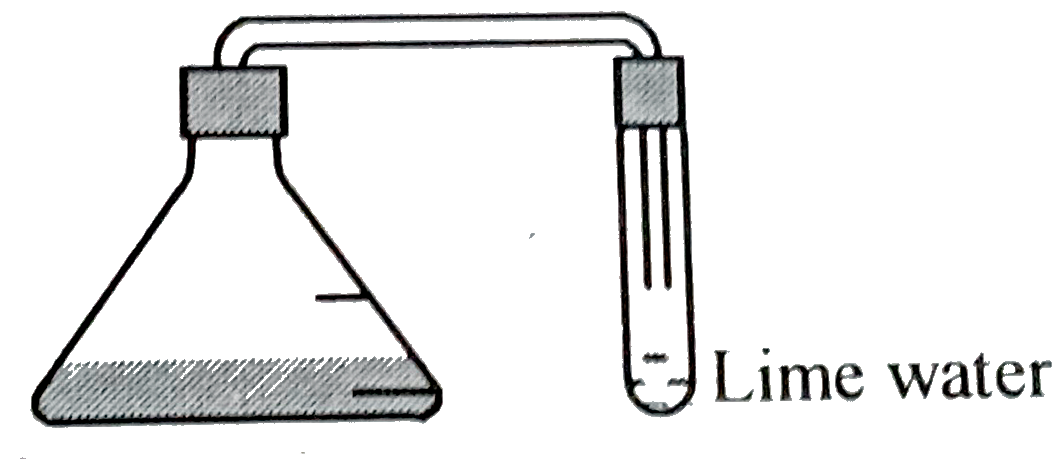A one litre flask is full of reddish brown bromine fumes. The intensity of brown colour of vapour will not decrease appreciably on adding to the flask some :
pieces of marble
animal charcal powder
carbon tetrachloride
carbon disulphide
The correct Answer is:A
Step by step video, text & image solution for A one litre flask is full of reddish brown bromine fumes. The intensity of brown colour of vapour will not decrease appreciably on adding to the flask some : by Chemistry experts to help you in doubts & scoring excellent marks in Class 11 exams.
Updated on:21/07/2023Topper's Solved these Questions
- SALT ANALYSISBOOK - GRB PUBLICATIONCHAPTER - SALT ANALYSISEXERCISE - E.Precipitation/Redox Reacttions
48 Videos
- SALT ANALYSISBOOK - GRB PUBLICATIONCHAPTER - SALT ANALYSISEXERCISE - F.Zero Group Cations
18 Videos
- SALT ANALYSISBOOK - GRB PUBLICATIONCHAPTER - SALT ANALYSISEXERCISE - C.Class- A Subgroup-I-Acidic Radicals
50 Videos
- S BLOCK ELEMENTSBOOK - GRB PUBLICATIONCHAPTER - S BLOCK ELEMENTSEXERCISE - SUBJECTIVE TYPE
9 Videos
- THERMODYNAMICSBOOK - GRB PUBLICATIONCHAPTER - THERMODYNAMICSEXERCISE - All Questions
704 Videos
Similar Questions
A student placed a gas jar containing air in the upside down position over a gas jar full of red-brown bromine vapours. He observed that the red-brown colour spread upwards into the jar containing air. Based on this observation, the student concluded that it is only the bromine vapour which moves up and diffuses into air in the upper jar, the air from the upper jar does not move down by diffusion into the lower jar containing bromine vapours. Do you agree with this conclusion of the student ? Give reason for your answer.
View Solution58.Which one of the following statements is incorrect?
1) In equilibrium mixture of ice and water kept in perfectly insulated flask mass of ice and water does not change with time.
2) The intensity of red colour increases when oxalic acid is added to a solution containing iron (III) nitrate and potassium thiocyanate.
3) On addition of catalyst the equilibrium constant value is not affected.
4) Equilibrium constant for a reaction with negative ΔH value decrease as the temperature increases.
View Solution
Knowledge Check
One litre flask is full of brown bromine fumes. The intensity of brown colour of vapour will not decreases appreciably on adding to the flask some
APieces of marbleBAnimal charcoal powderCCCl4DCS2A one litre flask is full of brown bromine vapour. The intensity of brown colour of vapour will not decreases appreciably on adding to the flask some
Apieces of marbleBanimal charcoal powderCcarbon tetrachlorideDcarbon disulphideA one litre flask is full of brown bromine vapours. The intensity of brown colour of vapour will not decrease apprciably on adding to the flask some.
APieces of marbleBAnimal charcoal powderCCarbon tetrachlorideDCarbon disulphide
Pinku took two closed vessels for carrying out two different reversible reactions. The first reaction was the thermal decomposition of cupric nitrate and the second reaction was the synthesis of iodine pentafluoride from its constituents. After the reactions reached the state of equilibrium, he changed the pressure on both the reaction mixtures keeping the other parameters unaltered. In the first reaction vessel, he observed that the intensity of brown colour had been decreasing and in the other reaction vessel, the intensity of purple colour had been increasing. Explain the reason behind such observation.
View SolutionThe break-down of glucose in a cell occurs in any of the following pathways :

Three experiments (A, B, C) have been set up. In each experiment, a flask contains the organism in growth medium, glucose and a brown dye that changes its colour to yellow when the pH decreases. The mouth of the flask is attached to a test tube containing lime water (Calcium hydroxide , as shown in the figure) . In C, but not in A and B , air is removed from the flask before beginning the experiment.
After a period of growth, the following observation were made :
A : Lime water turns milky , the dye colour remains the same
B : The dye colour changes , lime water does not turn milky
C : Lime water turns milky , the dye colour remains the same

(a) Question : Identify which of the reactions is the pathways depicted above is taking place in each experiment . Give reasons for your answer .
(b) Question : Identify which of the reactions in the pathways depicted above is expected to occur in Red Blood Cells (RBCs)
View SolutionA one litre is full of brown bromine vapours. The intensity of brown colour of vapours will not decrease appreciably on adding to the flask some
View SolutionWhen a gas jar containing colourless air is kept upside down over a gas jar full of brown-coloured bromine vapour, then after some time, the brown colour of bromine vapour spreads into the upper gas jar making both the gas jars appear brown in colour. Which of the following conclusion obtained from these observations is incorrect ?
View SolutionWhen a gas jar full of air is placed upside down on a gas jar full of bromine vapours, the red-brown vapours of bromine from the lower jar go upward into the jar containing air. In this experiment :
View Solution
